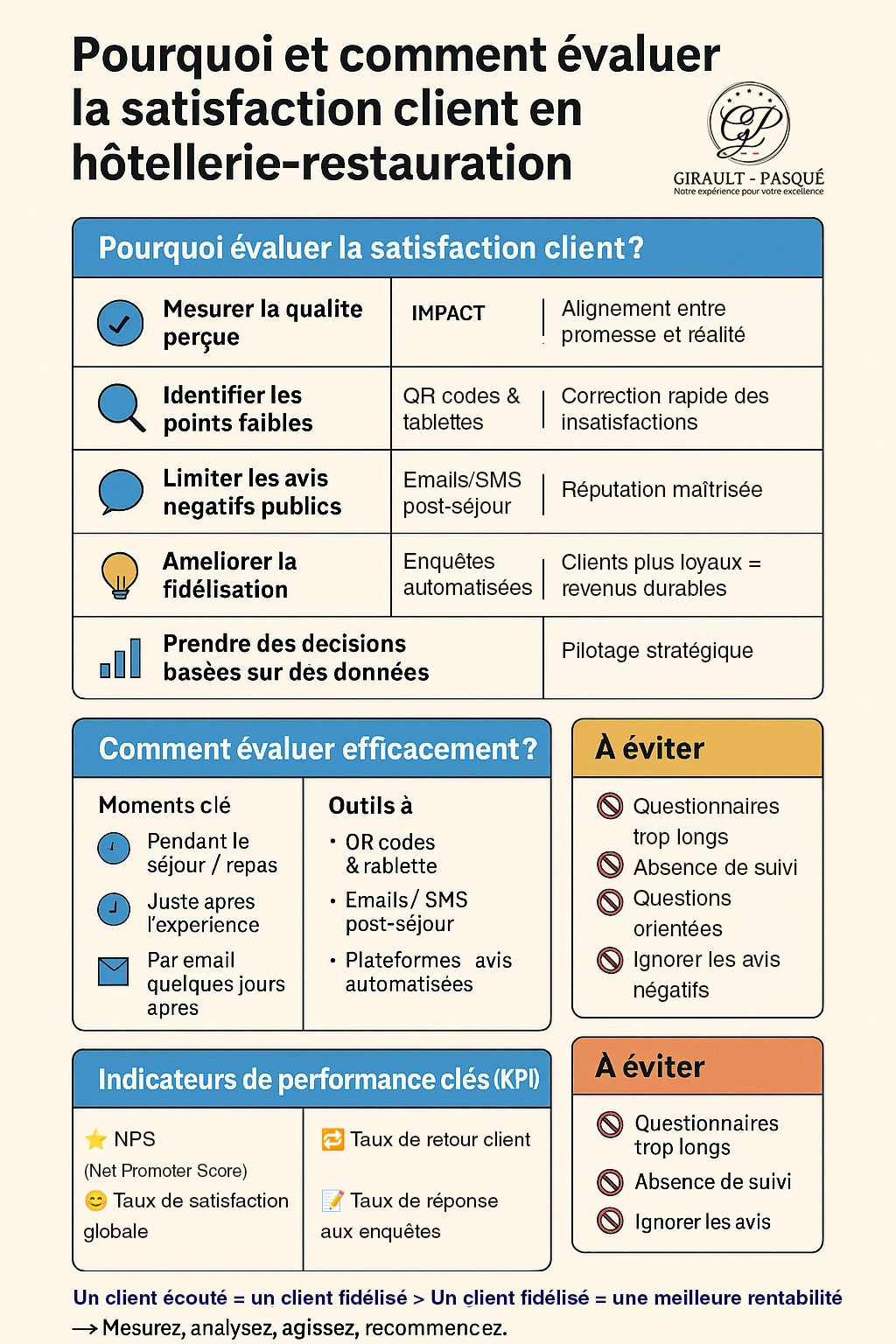In a sector as competitive as the hospitality industry, customer satisfaction is not a luxury, but a necessity. It directly impacts the establishment’s reputation, loyalty, profitability, and overall performance. Yet, too many hoteliers and restaurateurs still assess satisfaction in an approximate or ad hoc manner.
In this article, we will examine why it is important, even essential, to assess customer satisfaction in the hotel and restaurant sectors, and then how to implement an effective, structured, and ongoing approach.

1. Why evaluate customer satisfaction?
A key indicator of service quality
The customer experience is at the heart of the hotel and restaurant business. An impeccable room, attentive service, a delicious meal: these elements, when perceived positively, fuel satisfaction. Evaluating it allows you to objectively measure the true quality of what you offer.
Anticipate Negative Reviews and Dissatisfaction
A dissatisfied customer who expresses their opinion on a public platform can harm your image. By soliciting feedback before they post, you regain control of your communication. This is an opportunity to intervene, correct, and sometimes even turn an average experience into future loyalty.
Optimize Loyalty and Word of Mouth
A satisfied customer is not only more likely to return, but also to recommend your establishment to their friends and family. In a world where online reviews are king, digital word of mouth has become a powerful marketing tool. Measuring satisfaction can therefore fuel your loyalty and recommendation strategy.
Make Decisions Based on Concrete Data
Evaluating customer satisfaction provides reliable indicators to guide your choices. What needs to be improved? Where to invest? Which staff deserves to be valued? Without customer feedback, these decisions are based on impressions. With rigorous evaluation, they are based on facts.
Why evaluate customer satisfaction in a nutshell
| Reason | Impact |
|---|---|
| ✅ Measure perceived quality | Alignment between promise and reality |
| 🔍 Identify weak points | Quickly correct dissatisfaction |
| 💬 Limit negative public review | Control reputation |
| 💡 Improve retention | More loyal customers = sustainable revenue |
| 📊 Make data-driven decisions | Strategic management |
2. How to effectively assess customer satisfaction?
Choose the right moments to survey the customer
The assessment should not be intrusive, but it should be timely:
- During the stay/meal: to immediately detect and correct any dissatisfaction.
- At the end of the experience: at checkout or after the bill, for an immediate impression.
- A few days after departure: for a more thoughtful analysis, often via email.
A good balance between immediacy and perspective is essential.
Use appropriate tools
Here are some tools for collecting customer feedback:
- Satisfaction questionnaires: on tablets, via QR code, email, or SMS.
- Feedback kiosks: particularly in fast-food restaurants or buffets.
- Online surveys: through platforms like SurveyMonkey, Typeform, Google Forms.
- Unsolicited reviews: on Google, TripAdvisor, Booking.com, etc. These are valuable to analyze even if they are not solicited.
- Mystery shoppers: a more qualitative tool, useful for internal audits.
Structure questionnaires appropriately
A good questionnaire is:
- Short (5 to 10 questions maximum)
- Clear (plain language, no jargon)
- Targeted (on specific aspects: welcome, cleanliness, comfort, food quality, etc.)
- Mixed (closed-ended questions for statistics + open comment areas for qualitative questions)
Examples of questions:
- “On a scale of 1 to 10, would you recommend our establishment to a friend?”
- “What did we do best during your experience?”
- “What could we improve?”
Use key satisfaction indicators
Here are some essential KPIs:
- NPS (Net Promoter Score): Measures the likelihood of recommending a product.
- Overall satisfaction rate: % of very satisfied customers.
- Return rate: % of loyal customers.
- Survey response rate: An indicator of customer engagement.
- Average rating across platforms: Monitor regularly.
Process and analyze feedback
The analysis can be automated using certain tools (hotel CRM, guest feedback software), but above all, it must:
- Identify recurring points of friction
- Identify employees cited positively or negatively
- Prioritize actions to be taken based on frequency and impact
Communicate results and involve teams
Sharing results with your staff is essential:
- To recognize successes
- To motivate improvement in weak areas
- To involve each employee in service quality
Consider incorporating the results into your team meetings and displaying positive customer comments in break or training areas.
Key Performance Indicators (KPIs) at a glance:
| Indicator | Usefulness |
|---|---|
| ⭐ NPS (Net Promoter Score) | Measures the likelihood of recommending. |
| 😊 Overall satisfaction rate | % of very satisfied customers |
| 🔁 Return rate | % of loyal customers |
| 📝 Survey response rate | An indicator of customer engagement. |
| 🌐 Average rating on platforms | Monitor regularly |



3. Common Mistakes to Avoid
- Too many questions: the customer abandons the survey.
- Lack of follow-up: if you don’t take any action on the feedback, the customer will notice.
- Biased questionnaires: asking leading questions can skew the results.
- Ignoring negative feedback: it’s often the most useful for progress.
In conclusion: Customer satisfaction is a strategic approach.
Evaluating customer satisfaction in the hospitality industry isn’t an option; it’s a strategic approach. It allows you to continually improve the experience, build customer loyalty, enhance your online image, and stand out from the competition.
It’s a virtuous circle: the more you listen to your customers, the more you improve; the more you improve, the more you build loyalty. In an industry where every detail counts, this active listening becomes your greatest asset.


